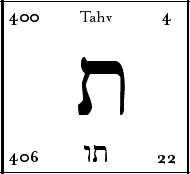A • B • C • D • E •
F • G • H • I • J • K • L •
M
N • O • P • Q • R •
S • T • U • V • W • X • Y •
Z
Hebrew:
Aleph • Beit • Geemel • Dalet •
Hay • Vahv • Zaiyin • Chait • Tait
Yoad • Kaf • Lahmed • Mame • Nune •
Sahmek • Aiyin • Pay
Tzahday • Qoaf •
Raysh • S(h)een • Tahv

Tahv
Spelling: tahv vahv
In shape, the tahv resembles a dalet joined to an upside-down
vahv (some say a nune). In shape, it appears similar to raysh,
but the ‘face’ is emphasized — and the little foot may represent
a beard, implying ‘The ancient’ or ‘the revered one’.
In the proto-hebraic
script, tahv was an ‘x’, and represented the extremely general
concept of
a mark,
and also of unification and crossing over. Like the signature
of an author, tahv is the ‘seal’ of the Holy One upon the processes
and
relations,
interreflections
and
functions
of the letters. Like aleph, the beginning, all letters are unified
in tahv.
Tahv is the beginning of the word for ‘beginning’ (tahv chait
lahmed hey) and the end of the word for ‘truth’ — (aleph mame tahv)
— which also means faithfulness and firmness. The last three letters
are the last three letters of the final three words of the story
of creation in Genesis II — bara Elohim la’asot — usually
translated as ‘God in creating had made.’ Supernal truth, a truth
alien to common human understanding is ‘the mark’ or ‘impression’
— the signature of God in all worlds, beings, relations, forms,
circumstances and events. This is a hidden truth, a truth existing
and expressing itself in a dimension which is neither light nor
dark, but has a quality of living imagination which exists against
a living ‘ocean’. Aleph, the pulsating source of unity and creation
— through mame — the living waters which represent undifferentiated
potential — to tahv, the Creation itself, which contains its source
in infinitely expanding unique reflection and form.
Tahv is sometimes understood to represent character brought forward
across a gap — such as the gap of personal death, or the end of
an experience. In this way it has a connotation related to re-incarnation
— the carrying of bits and pieces of previous lives and experience
in the vessel of this life.
As ‘a sign’ tahv implies understanding of circumstance, and the
physical or overt representation of this understanding. It is related
to the Earth, as a vessel into which the complete character of
the supernal kingdom flows, and in which everything which exists
‘above’ is signified.
Tahv is a mirror of aleph, but one existing in all possible dimensions.
It is a paradox, for it is not only the end of the aleph-beit,
but its beginning — so too is aleph, in a way which is an inversion
of tahv. As beginning and end, each contain and uniquely reflect
the sum of the letters. We could start at tahv, and proceed backwards,
arriving at entirely new understandings, which a wise person would
certainly pursue.
Both aleph and tahv are truly mysteries, and anything we may devise
to explain or describe them is thus of necessity incomplete.
o:O:o
o:O:o
Family: Supernal: Combining and unifying the archetypal
and the existential. The last four (or nine if one includes sophit
letters) letters. The accomplishment of Creation outside time and
space, and the perfection of the existential dimension.
Archetypal: Dalet
Existential: Mame
Supernal: Tahv
Position: The twenty-second letter.
The seventh of ‘the doubles’,
letters which have a dual pronunciation (hard or soft) with the
exception of raysh. This can be understood as a polarity between
a quality and its derivative opposite, and also a harsh or lenient
perspective of judgment.
Common associations:
Primary Significations: A mark. A sign. A signature.
Secondary Significations: Grace and primitivity.
Body: The mouth.
Planet: Jupiter.
Archetype/Tribe: David
Element:
Path on the Tree of Life:
Traditional: Yesod / Malkuth
Hermetic: Yesod / Malkuth
A • B • C • D • E • F • G • H • I • J • K • L • M
N • O • P • Q • R • S • T • U • V • W • X • Y • Z
Hebrew:
Aleph • Beit • Geemel • Dalet • Hay • Vahv • Zaiyin • Chait • Tait
Yoad • Kaf • Lahmed • Mame • Nune • Sahmek • Aiyin • Pay
Tzahday • Qoaf • Raysh • S(h)een • Tahv